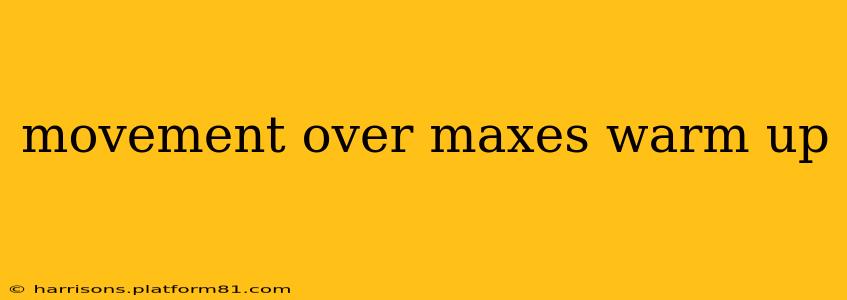Many lifters prioritize hitting their maxes, focusing solely on pushing their limits. However, a smart warm-up routine that emphasizes movement over maxes can significantly improve performance, reduce injury risk, and enhance overall training effectiveness. This approach focuses on preparing your body for the specific demands of your workout through controlled, dynamic movements rather than heavy lifting in the warm-up phase.
This article will delve into the benefits of a movement-focused warm-up, contrasting it with the traditional max-focused approach. We'll also address common questions surrounding warm-up strategies and provide practical examples you can implement into your own routine.
Why Movement Trumps Maxes in Your Warm-up
The goal of a warm-up isn't to exhaust yourself with heavy weights before your main workout. Instead, it's to gradually increase your body temperature, improve blood flow to your muscles, increase range of motion, and mentally prepare for the task ahead. Lifting heavy during your warm-up can lead to fatigue, increase your risk of injury, and ultimately hinder your performance on your target lifts.
A movement-focused warm-up emphasizes dynamic stretches and lighter weight exercises to prepare your body for the specific movements you'll be performing. This approach focuses on improving neuromuscular coordination and activating the necessary muscle groups, setting the stage for optimal performance.
What are the benefits of a movement-based warm-up?
-
Reduced Injury Risk: A proper warm-up increases blood flow to your muscles and joints, improving elasticity and reducing the risk of strains and tears. Pushing heavy weight in your warm-up increases the likelihood of injury.
-
Improved Performance: By preparing your body and nervous system for the upcoming workout, a movement-focused warm-up sets you up for stronger, more efficient lifts with better form.
-
Increased Range of Motion: Dynamic stretches increase flexibility and mobility, enabling you to move through a fuller range of motion during your workout.
-
Enhanced Mental Preparation: A focused warm-up helps you mentally transition into your workout, improving concentration and focus.
What does a movement-focused warm-up look like?
A good movement-focused warm-up typically includes:
-
General Warm-up (5-10 minutes): Light cardio, such as jogging, jumping jacks, or rowing, to elevate your heart rate and increase blood flow.
-
Dynamic Stretching (5-10 minutes): Focus on movements that mimic the exercises you'll be performing. Examples include arm circles, leg swings, torso twists, and dynamic stretches specific to the muscle groups you'll be targeting.
-
Specific Warm-up Sets (3-5 sets): Use lighter weights (around 30-50% of your working weight) to perform the exercises you'll be doing in your workout. Focus on proper form and technique.
How long should my warm-up be?
The ideal length of your warm-up will vary based on your individual needs and the intensity of your workout. A general guideline is 15-20 minutes, but you may need more or less time depending on your workout. Listen to your body; you should feel warm, loose, and ready to perform.
Should I use heavy weights in my warm-up?
No, heavy weights do not belong in your warm-up routine. The purpose of a warm-up is preparation, not exhaustion. Heavy weights in your warm-up increase the risk of injury and can negatively impact your performance during your main workout.
What are some examples of dynamic stretches for a movement-based warm-up?
- Arm Circles: Forward and backward circles to warm up the shoulder joints.
- Leg Swings: Forward, backward, and side-to-side swings to improve hip mobility.
- Torso Twists: Gentle twists to improve spinal mobility.
- Cat-Cow: A yoga-based stretch that improves spinal flexibility and mobility.
- Walking Lunges: Improves hip and ankle mobility while activating the leg muscles.
By prioritizing movement over maxes in your warm-up, you can significantly improve your training outcomes, reduce injury risk, and optimize your performance. Remember to listen to your body and adjust your warm-up accordingly. The focus should always be on preparing your body for the work ahead, not fatiguing it before you've even begun.
